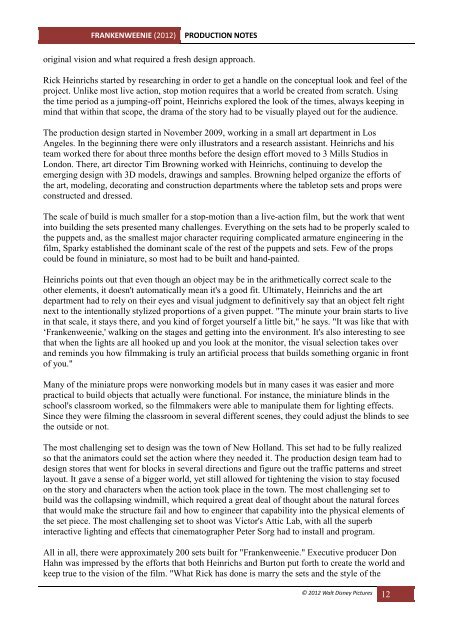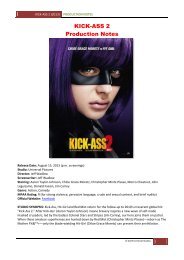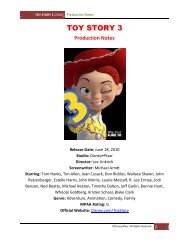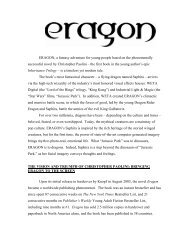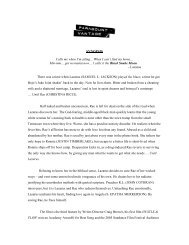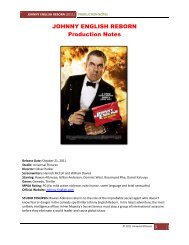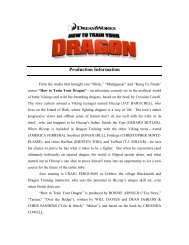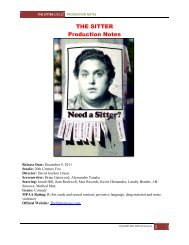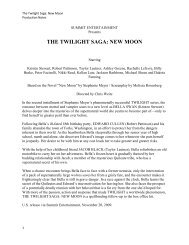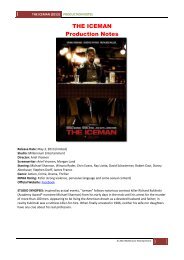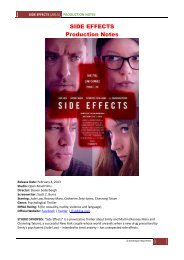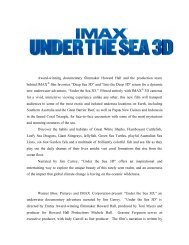FRANKENWEENIE Production Notes - Visual Hollywood
FRANKENWEENIE Production Notes - Visual Hollywood
FRANKENWEENIE Production Notes - Visual Hollywood
Create successful ePaper yourself
Turn your PDF publications into a flip-book with our unique Google optimized e-Paper software.
<strong>FRANKENWEENIE</strong> (2012)PRODUCTION NOTESoriginal vision and what required a fresh design approach.Rick Heinrichs started by researching in order to get a handle on the conceptual look and feel of theproject. Unlike most live action, stop motion requires that a world be created from scratch. Usingthe time period as a jumping-off point, Heinrichs explored the look of the times, always keeping inmind that within that scope, the drama of the story had to be visually played out for the audience.The production design started in November 2009, working in a small art department in LosAngeles. In the beginning there were only illustrators and a research assistant. Heinrichs and histeam worked there for about three months before the design effort moved to 3 Mills Studios inLondon. There, art director Tim Browning worked with Heinrichs, continuing to develop theemerging design with 3D models, drawings and samples. Browning helped organize the efforts ofthe art, modeling, decorating and construction departments where the tabletop sets and props wereconstructed and dressed.The scale of build is much smaller for a stop-motion than a live-action film, but the work that wentinto building the sets presented many challenges. Everything on the sets had to be properly scaled tothe puppets and, as the smallest major character requiring complicated armature engineering in thefilm, Sparky established the dominant scale of the rest of the puppets and sets. Few of the propscould be found in miniature, so most had to be built and hand-painted.Heinrichs points out that even though an object may be in the arithmetically correct scale to theother elements, it doesn't automatically mean it's a good fit. Ultimately, Heinrichs and the artdepartment had to rely on their eyes and visual judgment to definitively say that an object felt rightnext to the intentionally stylized proportions of a given puppet. "The minute your brain starts to livein that scale, it stays there, and you kind of forget yourself a little bit," he says. "It was like that with‘Frankenweenie,' walking on the stages and getting into the environment. It's also interesting to seethat when the lights are all hooked up and you look at the monitor, the visual selection takes overand reminds you how filmmaking is truly an artificial process that builds something organic in frontof you."Many of the miniature props were nonworking models but in many cases it was easier and morepractical to build objects that actually were functional. For instance, the miniature blinds in theschool's classroom worked, so the filmmakers were able to manipulate them for lighting effects.Since they were filming the classroom in several different scenes, they could adjust the blinds to seethe outside or not.The most challenging set to design was the town of New Holland. This set had to be fully realizedso that the animators could set the action where they needed it. The production design team had todesign stores that went for blocks in several directions and figure out the traffic patterns and streetlayout. It gave a sense of a bigger world, yet still allowed for tightening the vision to stay focusedon the story and characters when the action took place in the town. The most challenging set tobuild was the collapsing windmill, which required a great deal of thought about the natural forcesthat would make the structure fail and how to engineer that capability into the physical elements ofthe set piece. The most challenging set to shoot was Victor's Attic Lab, with all the superbinteractive lighting and effects that cinematographer Peter Sorg had to install and program.All in all, there were approximately 200 sets built for "Frankenweenie." Executive producer DonHahn was impressed by the efforts that both Heinrichs and Burton put forth to create the world andkeep true to the vision of the film. "What Rick has done is marry the sets and the style of the© 2012 Walt Disney Pictures12


